Companies can gain an advantage from anticipating their competitors’ strategic moves. Yet companies change their strategies for a host of reasons, some external, such as broad economic changes or competitors’ moves, and some internal, such as the results of a strategic planning process. This survey asked executives from around the world about the strategic choices they made in the previous year and about a single strategic initiative their company undertook spontaneously for any reason other than responding to competitors’ moves:1 the impetus for the initiative; the initiative’s goal and how the initiative differed from the old strategy; the company’s performance before the change; the amount of time devoted to planning and implementing the new initiative; and the degree to which this initiative was typical of the company’s strategic initiatives.
The results indicate that astute companies have a solid chance to figure out what kinds of strategic initiatives their competitors will undertake spontaneously and when they’ll act. For example, 82 percent of respondents say their company’s largest strategic move in the past year was a logical next step in their existing strategy. Further, when asked about the single biggest strategic initiative their company had undertaken spontaneously in the past five years, 85 percent say their new strategy was undertaken in addition to—not in replacement of—their existing strategy, and 61 percent say the new initiative continued in the same direction as the old one. Only 29 percent say their company actively searched for a new strategy in the past five years, instead of responding to a challenge or opportunity—most of which would be equally visible to their competitors. Finally, when implementing their new strategy, only 23 percent introduced it to the market without warning.
The survey also suggests that there’s one group of competitors to watch closely: executives who say that their companies were beating the competition on meeting financial targets before they undertook a new strategic initiative also say their companies are the likeliest to undertake a search for a new initiative—implying they are the likeliest to move for reasons not necessarily visible to other companies—and say that they are likelier to succeed with their initiative. Among respondents who know the financial outcome of their new initiative, three-quarters at outperforming companies say it met or exceeded financial targets, while only half at underperformers say the same.
New initiatives, few surprises
In the past fiscal year, excluding changes in strategy related to the ongoing global economic turmoil, the largest strategic initiative at 82 percent of companies was some logical extension of their existing strategy (Exhibit 1).
When asked to define the nature of their company’s most significant strategic initiative in the past five years—again excluding any initiative undertaken in response to a competitor’s move or in response to the current global economic turmoil—respondents describe several different types of moves (Exhibit 2).
However, respondents say their companies consider few options when deciding on a new strategy spontaneously; some two-thirds analyze two or fewer alternative strategies. This practice suggests that out-of-the-box surprises from competitors will be rare. (Similarly, an earlier survey found that companies assess few alternatives when deciding how to respond to a competitor’s move. Half of the respondents to that survey said their company assessed only two or three alternative responses.2 )
More of the same
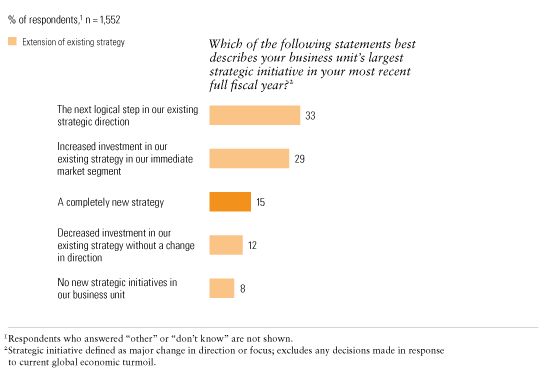
A variety of strategic initiatives
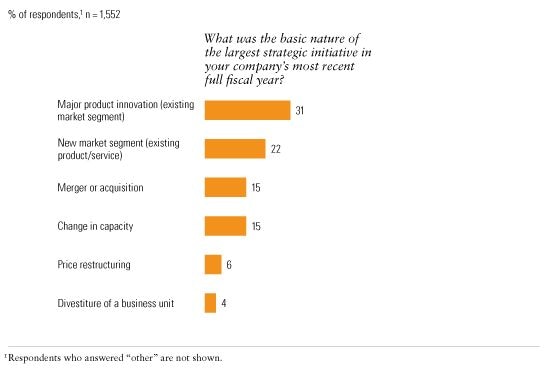
Finally, companies tend not to undertake strategic initiatives quickly. On average, those who searched took 7 months to decide what to do. And once companies arrived at a decision, implementation took them an average of another 13 months. This implies that most companies have over one and one-half years to figure out what their competitors are likely to do. Companies that have an annual planning process have at least one opportunity to ferret out competitors’ potential plans and might have two. Pricing changes are by far the speediest to hit the market, with 56 percent saying they implemented these strategy changes in 6 months or less.
Rarity of radical change
When executives describe their company’s most significant strategic initiative over the past five years, 61 percent say it continued in the same direction as the existing strategy, and 85 percent say it was undertaken in addition to that strategy (Exhibit 3).
Why change?
Two-thirds of respondents say their company’s largest strategic initiative in the past five years that was not driven by economic crisis or competition was undertaken as a result of some other external challenge or opportunity—and most of those challenges or opportunities result from factors that should be equally visible to companies paying attention to the external events affecting their industry (Exhibit 4, Exhibit 5). Indeed, even among those with the worst financial performance before undertaking this initiative, only a quarter actively sought out their new strategy without the spur of a challenge or opportunity.
Strengthening existing strategy
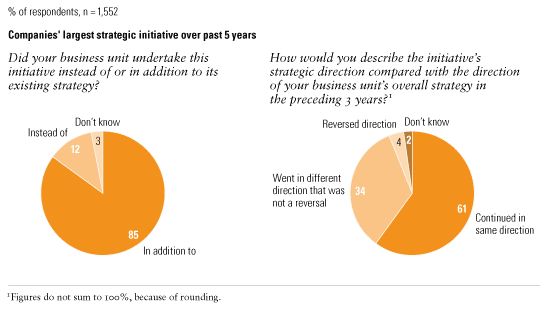
Reactive strategies
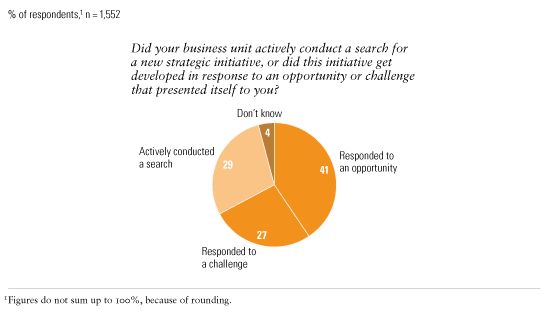
Where opportunities and challenges arise
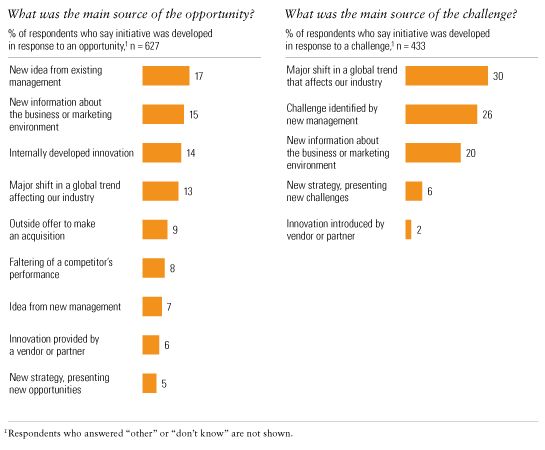
Among the 29 percent of respondents who say their company actively searched for its new strategic initiative, more than half—54 percent—say they did so as part of their annual planning process, the timing of which is typically well understood by competitors. Given the average length of time it takes companies to make and implement decisions, this finding indicates that many companies will have time to gain some idea of when their competitors’ new initiatives will hit the market, even when those initiatives are undertaken for reasons that are purely internal. Only 7 percent of all respondents say they actively searched for their strategic initiative on an ad hoc basis even though they have a strategic planning process.
Competitors to watch
Executives who say their companies were outperforming their financial targets before undertaking their strategic initiative are likelier to say their company is succeeding with its new initiative. Though people at companies that are doing well are likelier to think any new initiative will also do well, the differences are statistically significant and striking enough to indicate that these companies present more of a challenge than other competitors. These companies are also likelier to surprise. One reason is that these companies are likelier than others to have conducted a search for a new initiative; about a third of them do so, compared with a quarter of underperformers. Another is that those outperformers who search are a bit less likely than the overall group to say their new initiative continued in the same direction as their old strategy, at only 56 percent. Outperformers are also much likelier than underperformers to say their reason to undertake a search for a new initiative was to preempt potential competitive threats. This is likely because outperformers have a competitive edge they’re seeking to sustain, because they have the luxury of doing so (instead of having to meet market expectations), or both. This motivation makes their potential moves harder to anticipate than initiatives prompted by events such as regulatory changes or shifts in global trends, which are visible to all competitors (though companies that are tracking potential competitive threats should have some insight into their potential preemption moves as well). The only good news from the survey for these companies’ competitors is that nearly two-thirds of outperformers that searched for a new strategic initiative say they undertook their search as part of their annual planning process, indicating that competitors can at least predict when they are likely to make a spontaneous move.
Looking ahead
The very small number of companies that completely replace their strategies or reverse direction suggests that few competitors are likely to generate real surprises. Companies should not spend the majority of their strategic-planning time trying to anticipate all of their competitors’ possible strategic moves.
The timing of many competitors’ moves can be predicted, because these moves either result from an annual planning process or are prompted by external events visible to all companies. Companies should be sure they understand the external landscape of their industry at least as well as their competitors do (and investigate when their competitors conduct their annual planning process).
The competitors likeliest to succeed with new strategic initiatives are those that are already outperforming financially. These competitors are also the likeliest to search for a new initiative, making them the ones to focus on when watching for surprise strategic moves.